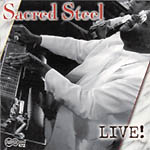|
Sacred Steel LIVE! Arhoolie CD 472 |

|
While steel guitar has lodged itself securely in white musical styles — country, pop, even Cajun — there’s not been much of a steel guitar tradition in black music. The bottleneck/slide mode has persisted, of course, and in such early recording artists as Casey Bill Weldon we find clear influence of the fascination with Hawaiian music that began about 1898, when the U.S. assumed control over the islands, and extended well into the ’40s, at which time the Decca Records catalog listed more than 500 Hawaiian titles.
The steel guitar has a rich heritage. One of the first recorded instrumental hits was "Floyd’s Guitar Blues," tacked pretty much as an afterthought onto an Andy Kirk session in March of 1939, with Floyd Smith playing an Epiphone Electar lap steel. Bob Dunn’s jagged, hornlike improvisations with Western swing bandleader Milton Brown provided a transition from older, Hawaiian-derived styles to single-string jazz playing — and some of the strangest solos ever put to wax. Sol Hoopii’s stylings of popular songs were everywhere in the ’20s; Bob Kaai, the finest of the Hawaiian players, contributed a handful of spectacular recordings, including a series of stunning jazz improvisations on "Home On the Range."
More recently, steel players like Buddy Emmons, Curly Chalker and Paul Franklin have embraced jazz and improvisational forms alongside their bread-and-butter work in country music. Yet despite a profound heritage of slide-playing even in black religious music — Blind Willie Johnson, Willie McTell, Sister O.M. Terrell come quickly to mind — Freddy Roulette and Sonny Rhodes almost alone have brought the steel, lap or Hawaiian guitar forward into contemporary black music.
A notable exception is that of the House of God, Keith Dominion, a Holiness-Pentecostal church where the steel guitar has, since about 1930, been central to services. This latest Arhoolie recording joins four previous CDs — Sacred Steel, the Campbell Brothers’ Pass Me Not, Jesus Will Fix It featuring Sonny Treadway, and Aubrey Ghent’s Can’t Nobody Do Me Like Jesus — in documenting a unique use of steel guitar.
This is a pure example of the folk process at work. Just as the banjo vanished from popular music to be retained in isolated mountain regions and from there reintroduced; just as New Orleans blacks were able to take up discarded woodwind and brass instruments from military bands to be had cheaply in pawn shops and to adapt them to their own music, creating jazz; the House of God has provided a refuge for steel guitar. As always in the process, adaptation, or transformation, is central. Employ of the steel guitar in House of God services hasn’t so much continued a tradition as it has created a new one.
It’s a peculiarity of the instrument that the steel can sound like an organ, a human voice, an entire string section, a lead guitar, even a miniature orchestra, and glimmers of all those possibilities are visible here. However eclectic, with touches of blues styling here, an accompaniment formed about a single riff or repeated rhythmic figure there, with even the inevitable train song, much of the playing on Sacred Steel Live! is vocal-oriented, often in patterns of call-and-response between voice and steel. Willie Eason’s work on such tracks as "Near the Cross" probably best defines the dominant style: voice-like, highly inflected, with soaring, sweeping dynamics, ethereal one moment, solid as sidewalk the next. Other highlights include Calvin Cooke on the Melobar, the Campbell Brothers’ fine ensemble work, and 22-year-old Robert Randolph’s pedal-steel improvisations on the hymn "Without God."
— James Sallis
| ©2000 Blues Access, Boulder, Colorado, USA |